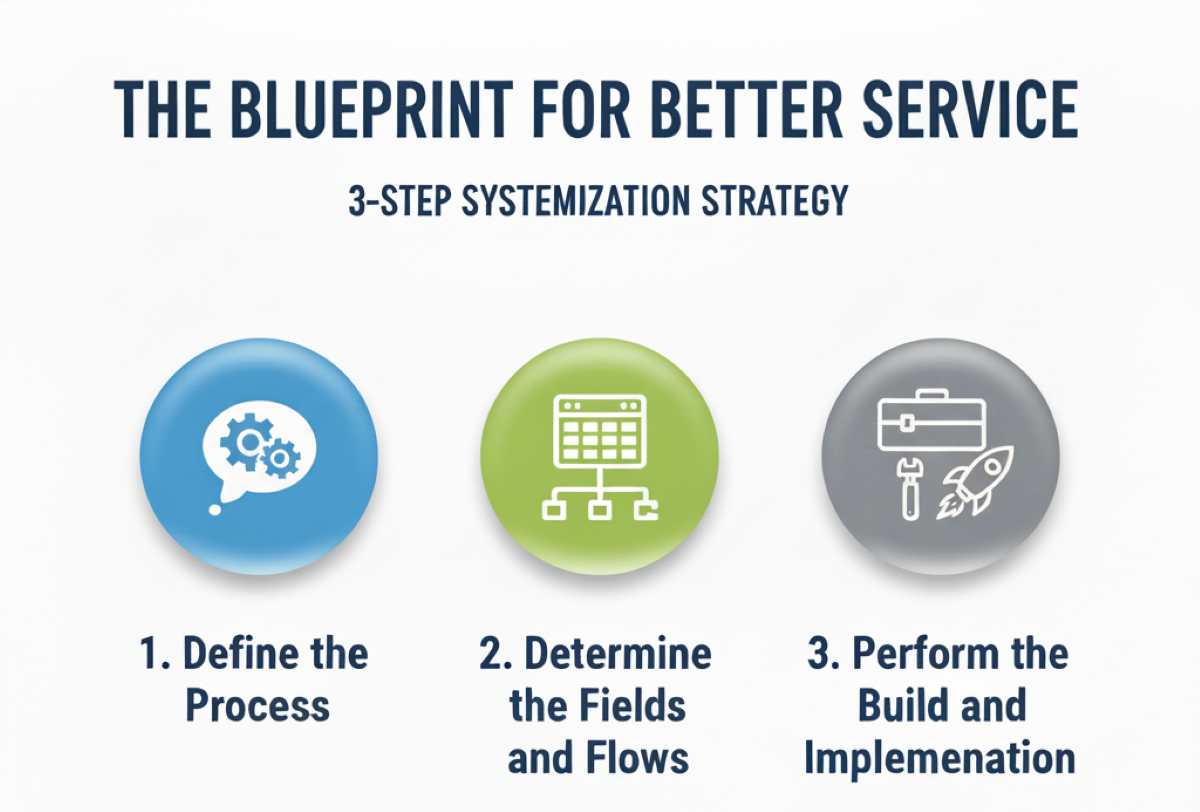Now Reading: The Blueprint for Better Service: Systemise your process in 3 Simple Steps🚀
-
01
The Blueprint for Better Service: Systemise your process in 3 Simple Steps🚀
The Blueprint for Better Service: Systemise your process in 3 Simple Steps🚀

As a Customer Service Director, you know the pain: processes are stuck in spreadsheets, systems don’t talk to each other, and your team is spending more time on admin than actually helping customers. The key to unlocking efficiency, compliance, and a superior customer experience isn’t just about choosing the latest tech—it’s about a strategic systemisation blueprint.
This three-step framework, applicable whether you’re using Power Apps, Dynamics, or any other platform, shifts the focus from solution-first to process-first. It’s the essential guide to building digital tools that truly align with your service goals.
A key point here is that each process should align to a key business strategy or procedure to get real impact. If you have more that one process or programme to deliver then create a road map so everyone can see the priorities.
1. Define the Process: Flip the Script on IT
The biggest mistake teams often make? Starting with the solution. For a truly effective system, your first step must be to focus entirely on the process. This means engaging with colleagues across the business—from the front line to management—to map out precisely how work gets done.
Key Actions for Process Definition:
- Map the Work, Mind the Rules: Don’t just sketch out the ideal workflow; ensure your map adheres to mandatory requirements. For example, if the Ombudsman mandates a five-working-day complaint acknowledgment, that’s non-negotiable in your process map.
- Secure Stakeholder Agreement: Getting everyone to agree on the actual process is challenging, but vital. This consensus is the foundation for everything that follows.
- Align with Strategy: Your process (e.g., Complaints or Anti-Social Behaviour management) must link directly to the organisation’s overarching strategy.
- Engage the Extremes: Ensure engagement captures both ends of the spectrum: the front-line users who execute the day job, and the managers who require crucial reporting data. This prevents building a system that satisfies reports but frustrates users.
Director’s Insight: The process definition helps critical integration decisions, identifying what, if any, data will need to be pulled across from other systems.
2. Determine the Fields and Flows: The ‘Nitty-Gritty’ of Data
Once the process is agreed upon, it’s time to dissect it into the necessary fields (data) and flows (automation). This step moves beyond the general workflow to define the nitty-gritty data logging required to fulfill the process and reporting needs.
Key Actions for Fields and Flows:
- Prioritise Reporting and Compliance: Identify the data that needs to be logged to meet both external requirements (like Ombudsman reports) and internal tracking needs.
- Minimise Free Text: Where possible, avoid free text fields. They are notoriously difficult to report on and introduce consistency errors. Favour controlled pick lists for clean, structured data.
- Define SLAs and Automation: Determine your internal Service Level Agreements (SLAs)—often stricter than external guidelines—and identify every opportunity for automation. Automating steps simplifies users’ lives, improves the experience, and keeps data consistent.
- Wireframe Before You Build: Before the IT team writes a line of code, use simple tools (like PowerPoint or Visio) to create wireframes—visualising what the screens will look like. This allows your users to sign off on the UI before the costly build begins.
- Data Security from the Start: Determine security and visibility. Restrictions can range from an individual record down to field level (e.g.: masking a staff member’s name).
Director’s Warning: Many organisations (using Dynamics or similar case management systems) have historically overloaded their systems with too many fields through quick fixes. Be ruthless: limit the number of fields to just those that capture fundamental data. Preventing screen overload and system bloat.
3. Perform the Build and Implementation: The Go-Live Strategy
The final step is execution: choosing the system and implementing the solution based on the requirements from Steps 1 and 2. Remember, your IT team and key stakeholders need to be a key part of the conversation since the start!
Key Actions for Build and Implementation:
- Engagement is Adoption: Use Show and Tells throughout the build process. These interactive sessions engage users, secure buy-in, and ensure adoption is baked in, not bolted on at the end.
- Scenario-Based UAT: User Acceptance Testing (UAT) must be performed by dedicated user resources—not IT checking their own work. Use realistic scenarios to verify the system truly meets the business needs.
- The Power of the Premortem: A few weeks before go-live, hold a premortem. Gather key stakeholders to discuss the “worst thing that could happen” if the system fails and identify solutions/ways to reduce the risk. This promotes a sensible, relaxed conversation about reducing risks before go live.
- Structured Go-Live Support: Beyond standard training, plan an accessible support phase, such as an open Teams meeting for a day or two where anyone can quickly drop in for help with immediate issues.
Director’s Checklist: When working with external contractors, ensure crystal-clear intellectual property (IP) ownership and robust third-party management to prevent system lock-down or unexpected subscription risks.
By following this three-step blueprint—Process first, Data second, Build last—you’ll systemise your processes not just with new technology, but with true, measurable efficiency and a system that the entire organisation will actually want to use.
Original Post https://deliveringcrm.net/2025/10/27/the-blueprint-for-better-service-systemise-your-process-in-3-simple-steps🚀/















